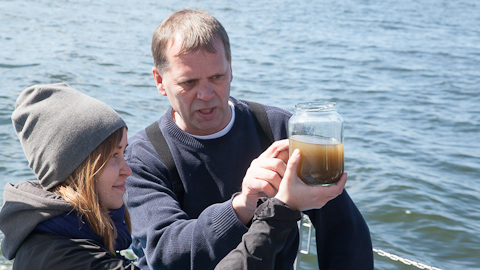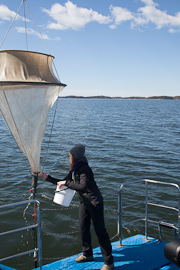Baltic Herring Spawning in the Finnish Archipelago Sea Now Feeds on Freshwater Copepod
The Baltic herring that spawns in the Finnish Archipelago Sea has learnt to feed on Limnocalanus, the freshwater copepod.

The change is significant, as the traditional principal nutriment of the Baltic herring, the saltwater copepods, are disappearing from the northern parts of the Baltic Sea. As a result, the Baltic herring caught at the Airisto, a 20-kilometre long stretch of sea near Turku, for example, has shrunk by a fourth during the past 30 years. The information is based on the long-term follow-up study by the Archipelago Research Institute of the University of Turku that celebrates its 50-year anniversary.
The Responsible Director of the Baltic herring research group of the Archipelago Research Institute, Jari Hänninen, says that the change in the Baltic herring population is due to climate change.
Because of climate change, the winds from the Atlantic now bring about more humid air that condenses over the river basin area of the Baltic Sea and rains down. Finally, it ends up in the main basin of the Baltic Sea and increases the amount of freshwater in the basin. This is accelerated by the fact that the winter storms prevent the flow of saltwater from the Denmark Strait to the basin filled with freshwater.
– There is more freshwater flowing into the Baltic Sea than ever before. The diversity of the animal plankton species has decreased, and, in practice, there are no saltwater copepods available for the Baltic herring. In approximately 30 years, the size of the Baltic herring has reduced with about 25 % in the Airisto, for example, says Hänninen, who is the Station Manager of the Archipelago Research Institute.
The reduction in size has been most prominent in the Baltic herring populations of the Gulf of Finland and the main basin of the Baltic Sea. According to the institute’s brand new research that is still in progress, the Baltic herrings that spawn in the Finnish Archipelago Sea and feed in the Sea of Bothnia are in the process of changing the situation.
– The growth reduction of the Baltic herring has not been as clear in the Sea of Bothnia as in the Gulf of Finland or in the main basin of the Baltic Sea, as the Baltic herrings in the Sea of Bothnia have got used to different kind of nutrition. They feed on the freshwater copepod Limnocalanus, says Hänninen.
Vendace of the Bay of Bothnia Is Sprawling Southward
The Finnish Archipelago Sea is the most important individual breeding ground for the Baltic herring. However, so far only the Baltic herrings that have spawned in the Finnish Archipelago Sea have learnt to feed on the freshwater copepods, as the change in the plankton populations cannot yet be observed, for example, at the Gulf of Finland. Nonetheless, Hänninen points out that due to climate change, the freshwater copepod species might spread out all the way to Gotland according to the long-term estimations, which could change the current situation.
The increasing amount of freshwater might also introduce new fish species to the Baltic Sea. Traditionally, species living in the Gulf of Finland as well as at the bottom of the Bay of Bothnia have included the freshwater vendace. With the increasing amount of freshwater, the vendace of the Bay of Bothnia has been estimated to sprawl to an even larger area.
– It is a unique situation worldwide that the vendace, a species of the salmoniforms, and the Baltic herring, a species of the clupeiforms, would coexist in the same waters. However, they are not likely to compete for the same nutrition. Vendace feed on small water fleas, whereas the Baltic herring is more selective and feeds on copepods, Hänninen says.
The Baltic Herring Research of the Archipelago Research Institute Turns 30
The University of Turku established the Archipelago Research Institute in 1964. Its ongoing Baltic herring research began 30 years ago.
The Baltic herring is one of the dominants in the Baltic Sea’s ecosystem, and, economically, one of the most important fish species in Finland. The Baltic herring research of the Archipelago Research Institute aims at increasing the knowledge of the biology of the Baltic herring.
– As the state of the Baltic Sea changes, we need versatile information on the characteristics of the species and the factors affecting them so that we can predict the development of the fish population and explain the changes in it. The research data is unique within the Baltic Sea area, says Katja Mäkinen, Preparator of the  Research Institute.
Research Institute.
Successful reproduction is the most important prerequisite for the species’ ability to maintain its vitality in its own habitat. Therefore, initially the Baltic herring research focused on the issues within the reproduction of the Baltic herring: where and when does the Baltic herring reproduce, how does the reproduction succeed and which factors regulate successful reproduction.
In addition to the research on the breeding grounds, researchers have followed up the characteristics of the Baltic herring population as the state of the Baltic Sea has changed. In the past few years, the research has focused on climate change and its impacts on the Baltic Sea. The research covers, for instance, the changes in the animal plankton and the Baltic herring populations, the Baltic herring’s use of nutrition, as well as the nutrition’s impact on the fish oils, of which especially the omega-3 fatty acids are crucial to the human health.
– The core of the research data consists of the time series collected in the course of 30 years. We utilise them to predict the changes in the Baltic herring population and the whole ecosystem if, for instance, the salinity of the Baltic Sea would diminish due to increased rainfall, Mäkinen says.
During the years, numerous researchers and students have been working in the Baltic herring research group. Currently, the Responsible Director is Docent Jari Hänninen and the members include Docent Marjut Rajasilta, Professor Ilppo Vuorinen and Docent Jukka-Pekka Suomela. The Archipelago Research Institute will be open to the public 17 July 2014.
Text: Erja Hyytiäinen
Translation: Aura Jaakkola